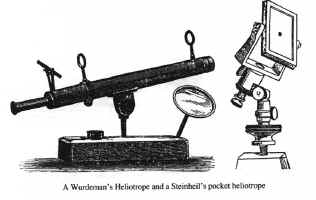|
 Article taken from "Backsights"
Magazine published by Surveyors Historical Society
Article taken from "Backsights"
Magazine published by Surveyors Historical Society
|
THE
HELIOTROPE
by Dale Beeks
The word "Heliotrope", when
examined in detail, means "the sun" and "to turn". It
is a fitting name for an instrument which does just that, reflects the sun
toward a given point.
The heliotrope was utilized by
surveyors as a specialized form of target; it was employed during large
triangulation surveys where, because of the great distance between stations
(usually twenty miles or more), a regular target would appear indistinct.
The heliotrope was limited to use on
sunny days and was further limited (in regions of high temperatures) to mornings
and afternoons when atmospheric aberration did not affect the instrument-man's
line of sight. The heliotrope operator was called a "heliotroper"
or "flasher" and would sometimes employ a second mirror for
communicating with the instrument station through heliography, a form of
language using impulsed reflecting surfaces.
 The
firm of Fauth & Company produced precise instruments for the U. S. Coast
Survey. A Fauth catalogue dated 1883 offered two different forms of
heliotropes: Wurdemann's heliotrope was a telescopic form which
incorporated two sights, tow signal mirrors and was offered with or without
graduated horizontal and vertical axis. A non-telescopic form known as
"Steinheil's Pocket Heliotrope" incorporated a flat mirror with a
non-silvered opening at the center of the plate. During the use of the
mirror, the angle of the cone of reflected sun offered a base diameter of about
50 feet at one mile and 1000 feet at 20 miles. Therefore, high accuracy
was not required when directing the mirror at the instrument station. The
firm of Fauth & Company produced precise instruments for the U. S. Coast
Survey. A Fauth catalogue dated 1883 offered two different forms of
heliotropes: Wurdemann's heliotrope was a telescopic form which
incorporated two sights, tow signal mirrors and was offered with or without
graduated horizontal and vertical axis. A non-telescopic form known as
"Steinheil's Pocket Heliotrope" incorporated a flat mirror with a
non-silvered opening at the center of the plate. During the use of the
mirror, the angle of the cone of reflected sun offered a base diameter of about
50 feet at one mile and 1000 feet at 20 miles. Therefore, high accuracy
was not required when directing the mirror at the instrument station.
It is interesting to note that in the
year 1879, a Mr. C. O. Boutelle with the Coast & Geodetic Survey,
experimented with night signals using argand and coal oil lamps as targets,
which were slightly more accurate than day observations and the cost of the
apparatus was less than that of a good heliotrope. He further noted that
night observations might be employed during periods of cloudy weather when
heliotropes could not be used. It is not certain whether this nocturnal
procedure was adopted by the Coast & Geodetic Survey.
| 